Abstract
Herpes simplex virus type 2 is a common human venereal pathogen which causes lethal neurological illness after intravaginal inoculation into BALB/cJ mice. To investigate whether an attenuated, nonlethal strain of this virus would confer immunity after inoculation of mice, we constructed a strain containing a partial deletion of the thymidine kinase gene, which is necessary for viral replication and spread in sensory ganglia. Unlike its wild-type counterpart, this deletion-containing strain of herpes simplex virus type 2 caused mild clinical disease and was not lethal when studied in an age-dependent murine model of intravaginal infection. Furthermore, after intravaginal infection, the deletion-containing strain could not be isolated from sensory ganglia at a time when wild-type virus was abundant. Of greater significance, intravaginal inoculation with the deletion-containing strain rendered mice completely resistant to rechallenge with a 10-fold 50% lethal dose of wild-type virus. These results suggest that a strain of herpes simplex virus type 2 containing a deletion of the thymidine kinase gene will be useful in studying the cellular basis of mucosal immunity in the genital tract.
Full text
PDF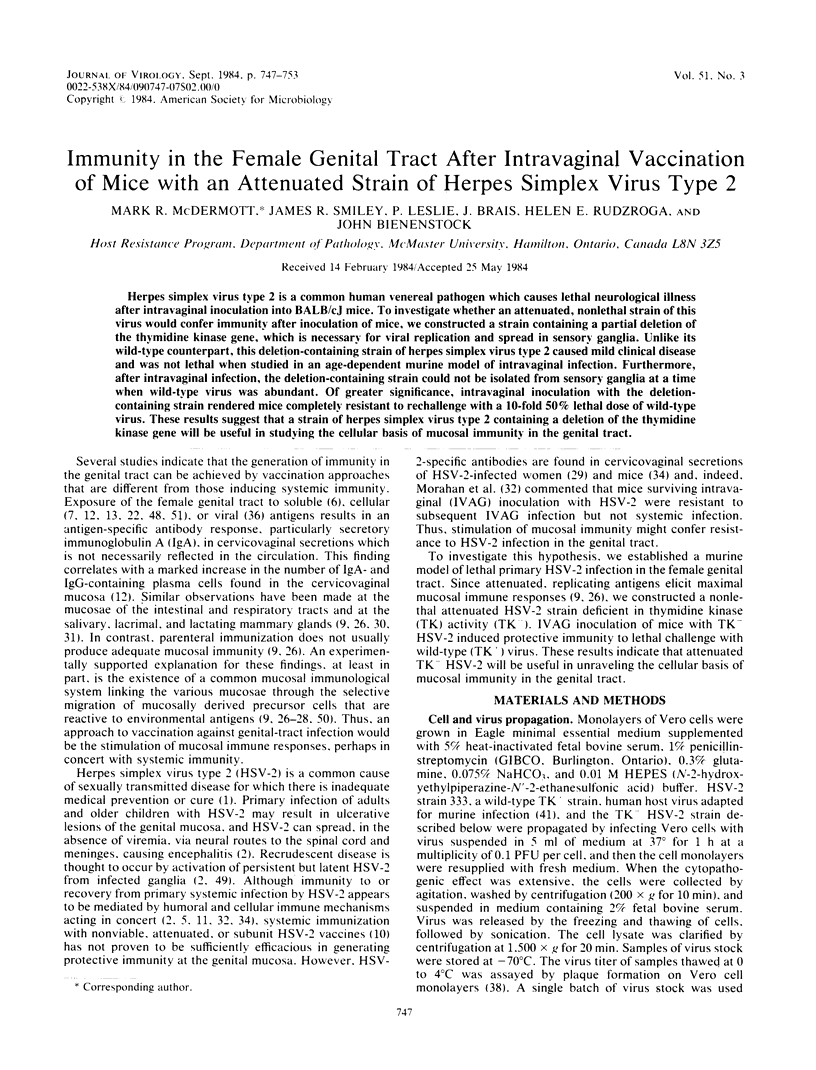
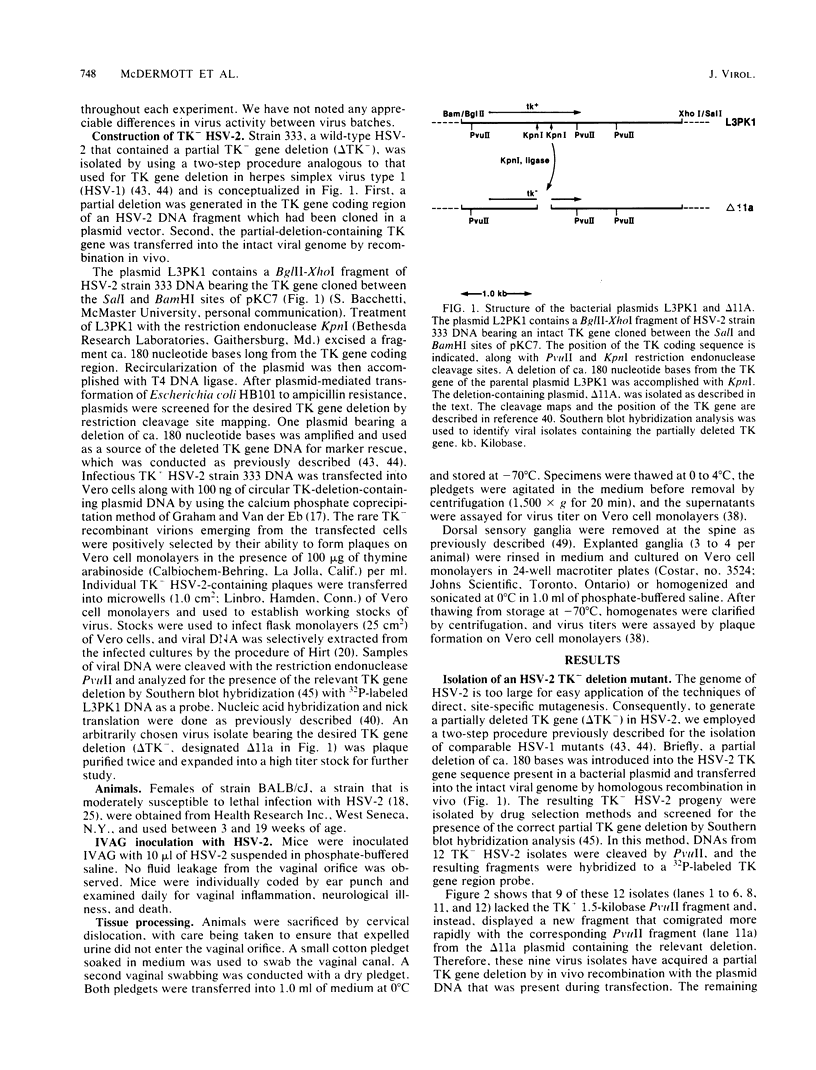
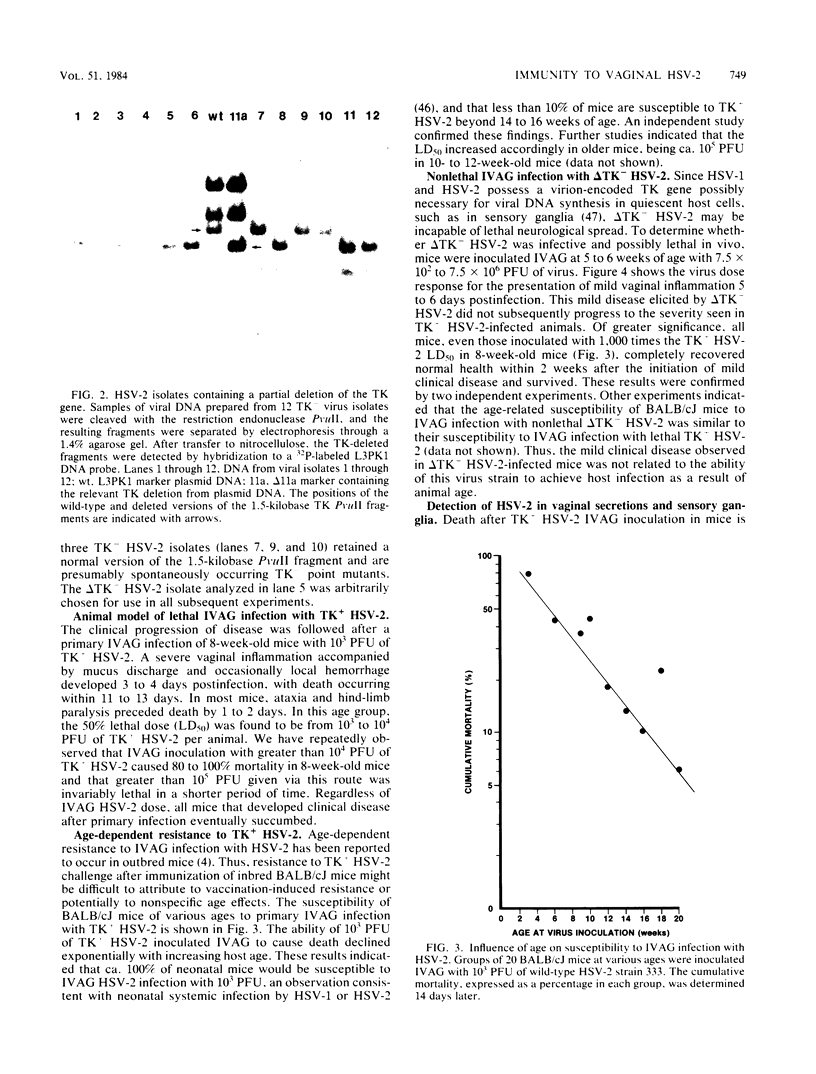
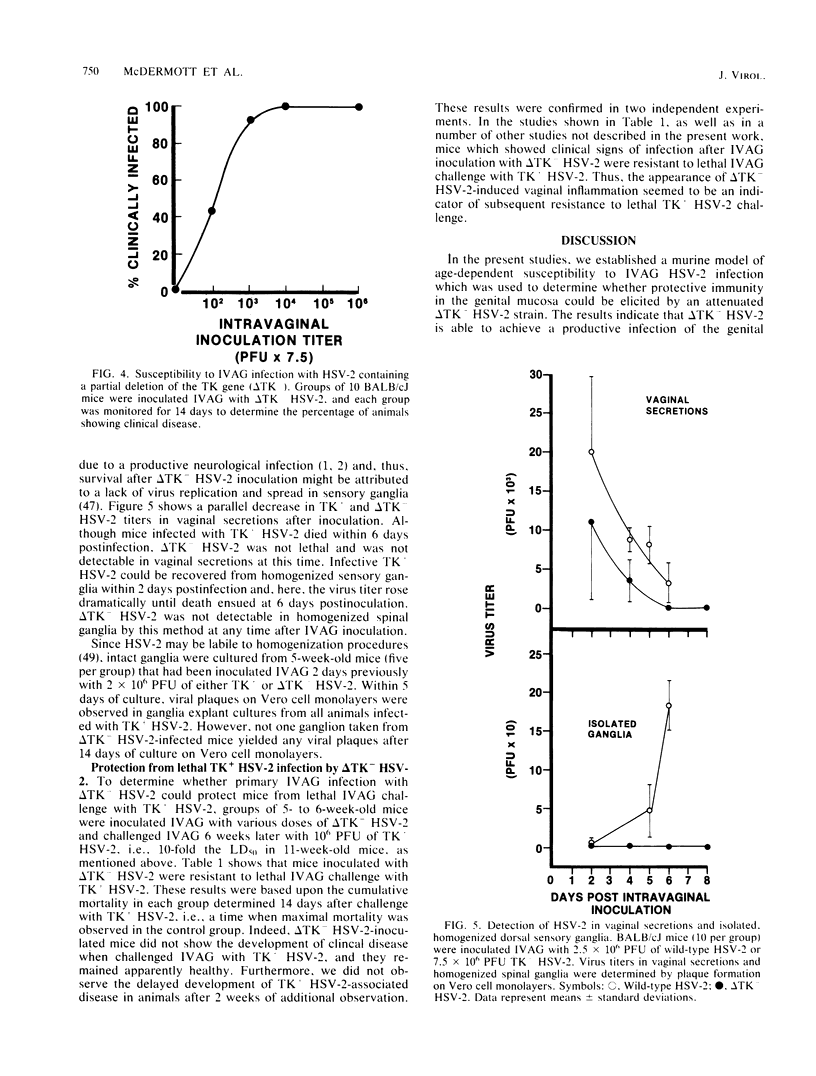
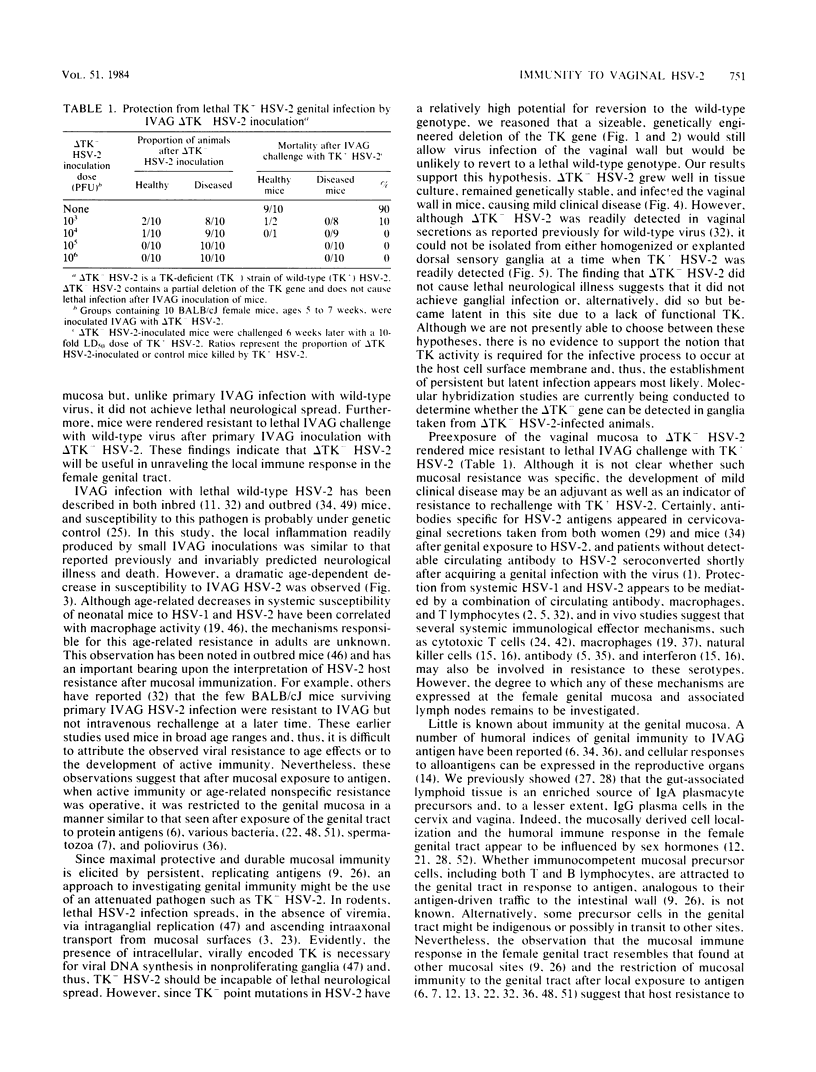
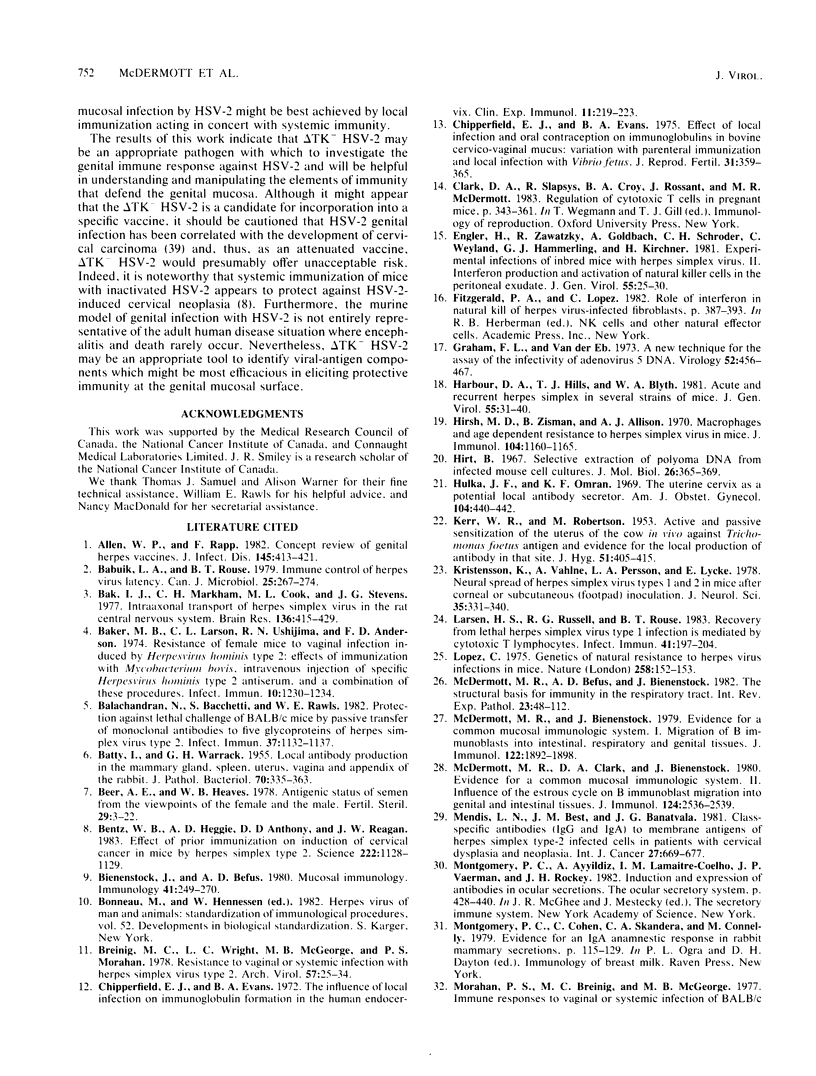
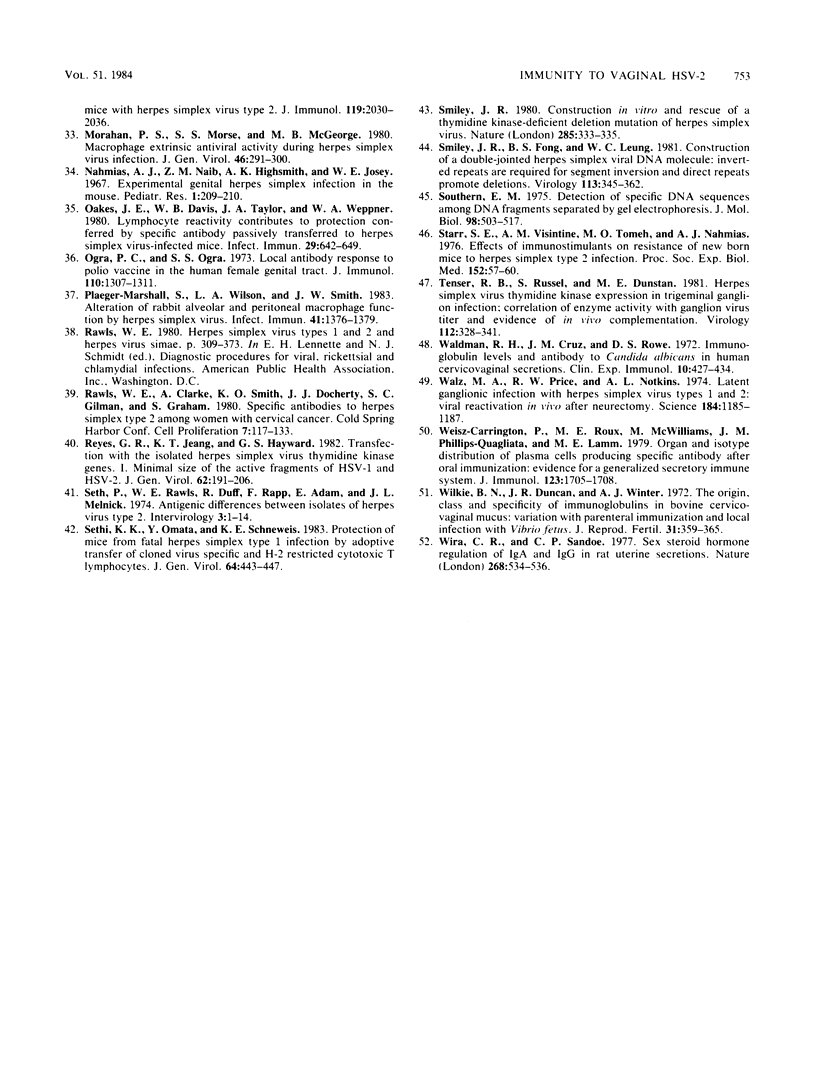
Images in this article
Selected References
These references are in PubMed. This may not be the complete list of references from this article.
- Allen W. P., Rapp F. Concept review of genital herpes vaccines. J Infect Dis. 1982 Mar;145(3):413–421. doi: 10.1093/infdis/145.3.413. [DOI] [PubMed] [Google Scholar]
- Babiuk L. A., Rouse B. T. Immune control of herpesvirus latency. Can J Microbiol. 1979 Mar;25(3):267–274. doi: 10.1139/m79-043. [DOI] [PubMed] [Google Scholar]
- Bak I. J., Markham C. H., Cook M. L., Stevens J. G. Intraaxonal transport of Herpes simplex virus in the rat central nervous system. Brain Res. 1977 Nov 18;136(3):415–429. doi: 10.1016/0006-8993(77)90067-1. [DOI] [PubMed] [Google Scholar]
- Baker M. B., Larson C. L., Ushijima R. N., Anderson F. D. Resistance of female mice to vaginal infection induced by Herpesvirus hominis type 2: effects of immunization with Mycobacterium bovis, intravenous injection of specific Herpesvirus hominis type 2 antiserum, and a combination of these procedures. Infect Immun. 1974 Dec;10(6):1230–1234. doi: 10.1128/iai.10.6.1230-1234.1974. [DOI] [PMC free article] [PubMed] [Google Scholar]
- Balachandran N., Bacchetti S., Rawls W. E. Protection against lethal challenge of BALB/c mice by passive transfer of monoclonal antibodies to five glycoproteins of herpes simplex virus type 2. Infect Immun. 1982 Sep;37(3):1132–1137. doi: 10.1128/iai.37.3.1132-1137.1982. [DOI] [PMC free article] [PubMed] [Google Scholar]
- Beer A. E., Neaves W. B. Antigenic status of semen from the viewpoints of the female and male. Fertil Steril. 1978 Jan;29(1):3–22. [PubMed] [Google Scholar]
- Bienenstock J., Befus A. D. Mucosal immunology. Immunology. 1980 Oct;41(2):249–270. [PMC free article] [PubMed] [Google Scholar]
- Breinig M. C., Wright L. L., McGeorge M. B., Morahan P. S. Resistance to vaginal or systemic infection with herpes simplex virus type 2. Arch Virol. 1978;57(1):25–34. doi: 10.1007/BF01315634. [DOI] [PubMed] [Google Scholar]
- Chipperfield E. J., Evans B. A. The influence of local infection on immunoglobulin formation in the human endocervix. Clin Exp Immunol. 1972 Jun;11(2):219–233. [PMC free article] [PubMed] [Google Scholar]
- DUGUID J. P., SMITH I. W., DEMPSTER G., EDMUNDS P. N. Non-flagellar filamentous appendages (fimbriae) and haemagglutinating activity in Bacterium coli. J Pathol Bacteriol. 1955 Oct;70(2):335–348. doi: 10.1002/path.1700700210. [DOI] [PubMed] [Google Scholar]
- Engler H., Zawatzky R., Goldbach A., Schröder C. H., Weyand C., Hämmerling G. J., Kirchner H. Experimental infection of inbred mice with herpes simplex virus. II. Interferon production and activation of natural killer cells in the peritoneal exudate. J Gen Virol. 1981 Jul;55(Pt 1):25–30. doi: 10.1099/0022-1317-55-1-25. [DOI] [PubMed] [Google Scholar]
- Graham F. L., van der Eb A. J. A new technique for the assay of infectivity of human adenovirus 5 DNA. Virology. 1973 Apr;52(2):456–467. doi: 10.1016/0042-6822(73)90341-3. [DOI] [PubMed] [Google Scholar]
- Harbour D. A., Hill T. J., Blyth W. A. Acute and recurrent herpes simplex in several strains of mice. J Gen Virol. 1981 Jul;55(Pt 1):31–40. doi: 10.1099/0022-1317-55-1-31. [DOI] [PubMed] [Google Scholar]
- Hirsch M. S., Zisman B., Allison A. C. Macrophages and age-dependent resistance to Herpes simplex virus in mice. J Immunol. 1970 May;104(5):1160–1165. [PubMed] [Google Scholar]
- Hirt B. Selective extraction of polyoma DNA from infected mouse cell cultures. J Mol Biol. 1967 Jun 14;26(2):365–369. doi: 10.1016/0022-2836(67)90307-5. [DOI] [PubMed] [Google Scholar]
- Hulka J. F., Omran K. F. The uterine cervix as a potential local antibody secretor. Am J Obstet Gynecol. 1969 Jun 1;104(3):440–442. doi: 10.1016/s0002-9378(16)34202-8. [DOI] [PubMed] [Google Scholar]
- KERR W. R., ROBERTSON M. Active and passive sensitization of the uterus of the cow in vivo against Trichomonas foetus antigen and the evidence for the local production of antibody in that site. J Hyg (Lond) 1953 Sep;51(3):405–415. doi: 10.1017/s0022172400015825. [DOI] [PMC free article] [PubMed] [Google Scholar]
- Kristensson K., Vahlne A., Persson L. A., Lycke E. Neural spread of herpes simplex virus types 1 and 2 in mice after corneal or subcutaneous (footpad) inoculation. J Neurol Sci. 1978 Feb;35(2-3):331–340. doi: 10.1016/0022-510x(78)90013-8. [DOI] [PubMed] [Google Scholar]
- Larsen H. S., Russell R. G., Rouse B. T. Recovery from lethal herpes simplex virus type 1 infection is mediated by cytotoxic T lymphocytes. Infect Immun. 1983 Jul;41(1):197–204. doi: 10.1128/iai.41.1.197-204.1983. [DOI] [PMC free article] [PubMed] [Google Scholar]
- Lopez C. Genetics of natural resistance to herpesvirus infections in mice. Nature. 1975 Nov 13;258(5531):152–153. doi: 10.1038/258152a0. [DOI] [PubMed] [Google Scholar]
- McDermott M. R., Befus A. D., Bienenstock J. The structural basis for immunity in the respiratory tract. Int Rev Exp Pathol. 1982;23:47–112. [PubMed] [Google Scholar]
- McDermott M. R., Bienenstock J. Evidence for a common mucosal immunologic system. I. Migration of B immunoblasts into intestinal, respiratory, and genital tissues. J Immunol. 1979 May;122(5):1892–1898. [PubMed] [Google Scholar]
- McDermott M. R., Clark D. A., Bienenstock J. Evidence for a common mucosal immunologic system. II. Influence of the estrous cycle on B immunoblast migration into genital and intestinal tissues. J Immunol. 1980 Jun;124(6):2536–2539. [PubMed] [Google Scholar]
- Mendis L. N., Best J. M., Banatvala J. E. Class-specific antibodies (IgG and IgA) to membrane antigens of Herpes simplex type 2-infected cells in patients with cervical dysplasia and neoplasia. Int J Cancer. 1981 May 15;27(5):669–677. doi: 10.1002/ijc.2910270514. [DOI] [PubMed] [Google Scholar]
- Morahan P. S., Breinig M. C., McGeorge M. B. Immune responses to vaginal or systemic infection of BALB/c mice with herpes simplex virus type 2. J Immunol. 1977 Dec;119(6):2030–2036. [PubMed] [Google Scholar]
- Morahan P. S., Morse S. S., McGeorge M. G. Macrophage extrinsic antiviral activity during herpes simplex virus infection. J Gen Virol. 1980 Feb;46(2):291–300. doi: 10.1099/0022-1317-46-2-291. [DOI] [PubMed] [Google Scholar]
- Oakes J. E., Davis W. B., Taylor J. A., Weppner W. A. Lymphocyte reactivity contributes to protection conferred by specific antibody passively transferred to herpes simplex virus-infected mice. Infect Immun. 1980 Aug;29(2):642–649. doi: 10.1128/iai.29.2.642-649.1980. [DOI] [PMC free article] [PubMed] [Google Scholar]
- Ogra P. L., Ogra S. S. Local antibody response to poliovaccine in the human female genital tract. J Immunol. 1973 May;110(5):1307–1311. [PubMed] [Google Scholar]
- Plaeger-Marshall S., Wilson L. A., Smith J. W. Alteration of rabbit alveolar and peritoneal macrophage function by herpes simplex virus. Infect Immun. 1983 Sep;41(3):1376–1379. doi: 10.1128/iai.41.3.1376-1379.1983. [DOI] [PMC free article] [PubMed] [Google Scholar]
- Reyes G. R., Jeang K. T., Hayward G. S. Transfection with the isolated herpes simplex virus thymidine kinase genes. I. Minimal size of the active fragments from HSV-1 and HSV-2. J Gen Virol. 1982 Oct;62(Pt 2):191–206. doi: 10.1099/0022-1317-62-2-191. [DOI] [PubMed] [Google Scholar]
- Seth P., Rawls W. E., Duff R., Rapp F., Adam E., Melnick J. L. Antigenic differences between isolates of herpesvirus type 2. Intervirology. 1974;3(1-2):1–14. doi: 10.1159/000149738. [DOI] [PubMed] [Google Scholar]
- Sethi K. K., Omata Y., Schneweis K. E. Protection of mice from fatal herpes simplex virus type 1 infection by adoptive transfer of cloned virus-specific and H-2-restricted cytotoxic T lymphocytes. J Gen Virol. 1983 Feb;64(Pt 2):443–447. doi: 10.1099/0022-1317-64-2-443. [DOI] [PubMed] [Google Scholar]
- Smiley J. R. Construction in vitro and rescue of a thymidine kinase-deficient deletion mutation of herpes simplex virus. Nature. 1980 May 29;285(5763):333–335. doi: 10.1038/285333a0. [DOI] [PubMed] [Google Scholar]
- Smiley J. R., Fong B. S., Leung W. C. Construction of a double-jointed herpes simplex viral DNA molecule: inverted repeats are required for segment inversion, and direct repeats promote deletions. Virology. 1981 Aug;113(1):345–362. doi: 10.1016/0042-6822(81)90161-6. [DOI] [PubMed] [Google Scholar]
- Southern E. M. Detection of specific sequences among DNA fragments separated by gel electrophoresis. J Mol Biol. 1975 Nov 5;98(3):503–517. doi: 10.1016/s0022-2836(75)80083-0. [DOI] [PubMed] [Google Scholar]
- Starr S. E., Visintine A. M., Tomeh M. O., Nahmias A. J. Effects of immunostimulants on resistance of newborn mice to herpes simplex type 2 infection. Proc Soc Exp Biol Med. 1976 May;152(1):57–60. doi: 10.3181/00379727-152-39327. [DOI] [PubMed] [Google Scholar]
- Tenser R. B., Ressel S., Dunstan M. E. Herpes simplex virus thymidine kinase expression in trigeminal ganglion infection: correlation of enzyme activity with ganglion virus titer and evidence of in vivo complementation. Virology. 1981 Jul 15;112(1):328–341. doi: 10.1016/0042-6822(81)90638-3. [DOI] [PubMed] [Google Scholar]
- Waldman R. H., Cruz J. M., Rowe D. S. Immunoglobulin levels and antibody to Candida albicans in human cervicovaginal secretions. Clin Exp Immunol. 1972 Mar;10(3):427–434. [PMC free article] [PubMed] [Google Scholar]
- Walz M. A., Price R. W., Notkins A. L. Latent ganglionic infection with herpes simplex virus types 1 and 2: viral reactivation in vivo after neurectomy. Science. 1974 Jun 14;184(4142):1185–1187. doi: 10.1126/science.184.4142.1185. [DOI] [PubMed] [Google Scholar]
- Weisz-Carrington P., Roux M. E., McWilliams M., PHILLIPS-Quagliata J. M., Lamm M. E. Organ and isotype distribution of plasma cells producing specific antibody after oral immunization: evidence for a generalized secretory immune system. J Immunol. 1979 Oct;123(4):1705–1708. [PubMed] [Google Scholar]
- Wentz W. B., Heggie A. D., Anthony D. D., Reagan J. W. Effect of prior immunization on induction of cervial cancer in mice by herpes simplex virus type 2. Science. 1983 Dec 9;222(4628):1128–1129. doi: 10.1126/science.6316503. [DOI] [PubMed] [Google Scholar]
- Wilkie B. N., Duncan J. R., Winter A. J. The origin, class and specificity of immunoglobulins in bovine cervico-vaginal mucus: variation with parenteral immunization and local infection with Vibrio fetus. J Reprod Fertil. 1972 Dec;31(3):359–365. doi: 10.1530/jrf.0.0310359. [DOI] [PubMed] [Google Scholar]
- Wira C. R., Sandoe C. P. Sex steroid hormone regulation of IgA and IgG in rat uterine secretions. Nature. 1977 Aug 11;268(5620):534–536. doi: 10.1038/268534a0. [DOI] [PubMed] [Google Scholar]



